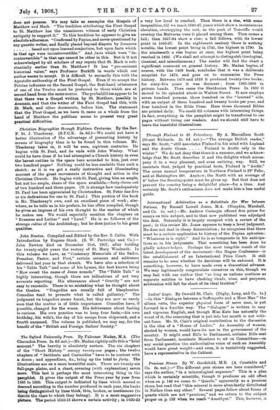The Oxford University Press. By Falconer Madan, M.A. (The Clarendon
Press. 2s. 6d. net.)—Mr. Madan rightly calls this a "brief account." The brevity is absolutely austere. The six chapters of the "Short History" occupy twenty-one pages ; the twelve chapters of "Incidents and Curiosities" have to be content with a dozen ; and appendixes, &c., bring up the total to forty. The illustrations are on a more bountiful scale. There are twenty-six full-page plates, and a chart, covering (with explanation) seven more. This last is perhaps the most interesting thing in the pamphlet. It gives the output of the Press year by year from 1585 to 1900. This output is indicated by lines which ascend or descend according to the number produced in each year, the books being distinguished by lines thick, thin, broken, or continuous (to denote the class to which they belong). It is a most suggestive picture. The period 1610-15 shows a certain activity ; in 1620-23 a very low level is reached. Then there is a rise, with some inequalities, till we reach 1640-47, years which show a mountainous elevation, overtopping the rest, as the peak of Teneriffe would overtop the Malverns were it placed among them. Then comes a fall; then 1657-64 show a rise; a fall follows, with its lowest point in 1695-97. In the eighteenth century there is nothing notable, the lowest point being in 1741, the highest in 1790. In the nineteenth a rise begins at once, the highest point being reached in 1892. (We shall not attempt to distinguish theological, classical, and miscellaneous.) The reader will find the chart a significant comment on general history. Mr. Madan begins, of course, with the 1468 book, concludes that it was a deliberate misprint for 1478, and goes on to summarise the Press history. Between 1478 and 1519 it produced twenty-two books ; for sixty-five years it was dormant ; from 1585-1669 in private hands. Then came the Sheldonian Press. In 1830 it moved to its splendid abode in Walton Street. It now employs seven hundred persons, three hundred on the "learned" side, with an output of three hundred and twenty books per year, and four hundred in the Bible Press. Here three thousand Bibles are printed daily. We could fill columns with interesting things. In fact, everything in the pamphlet might be transferred to our pages without tiring our readers. And we should still have to leave the beautiful illustrations.


















































 Previous page
Previous page